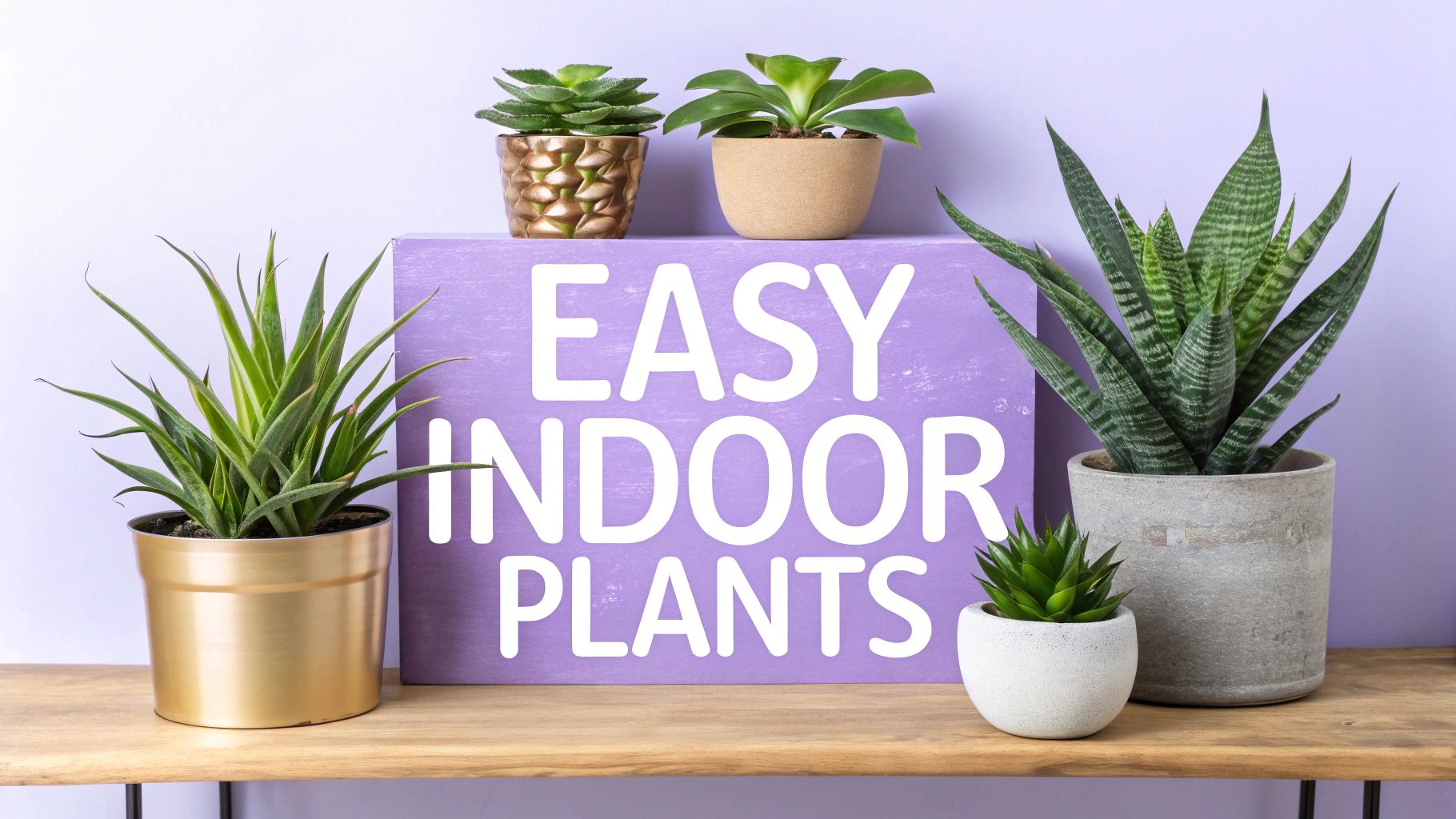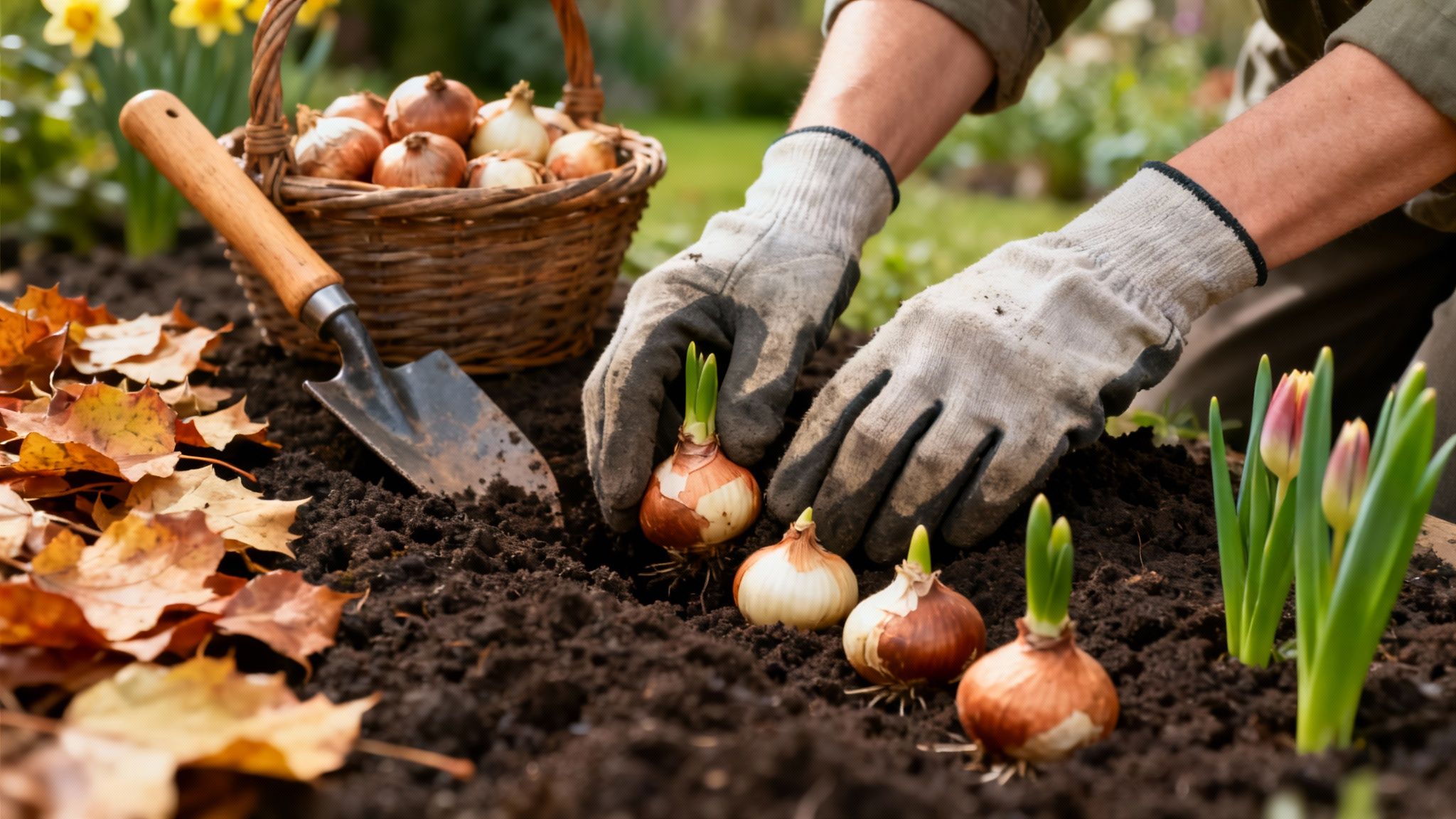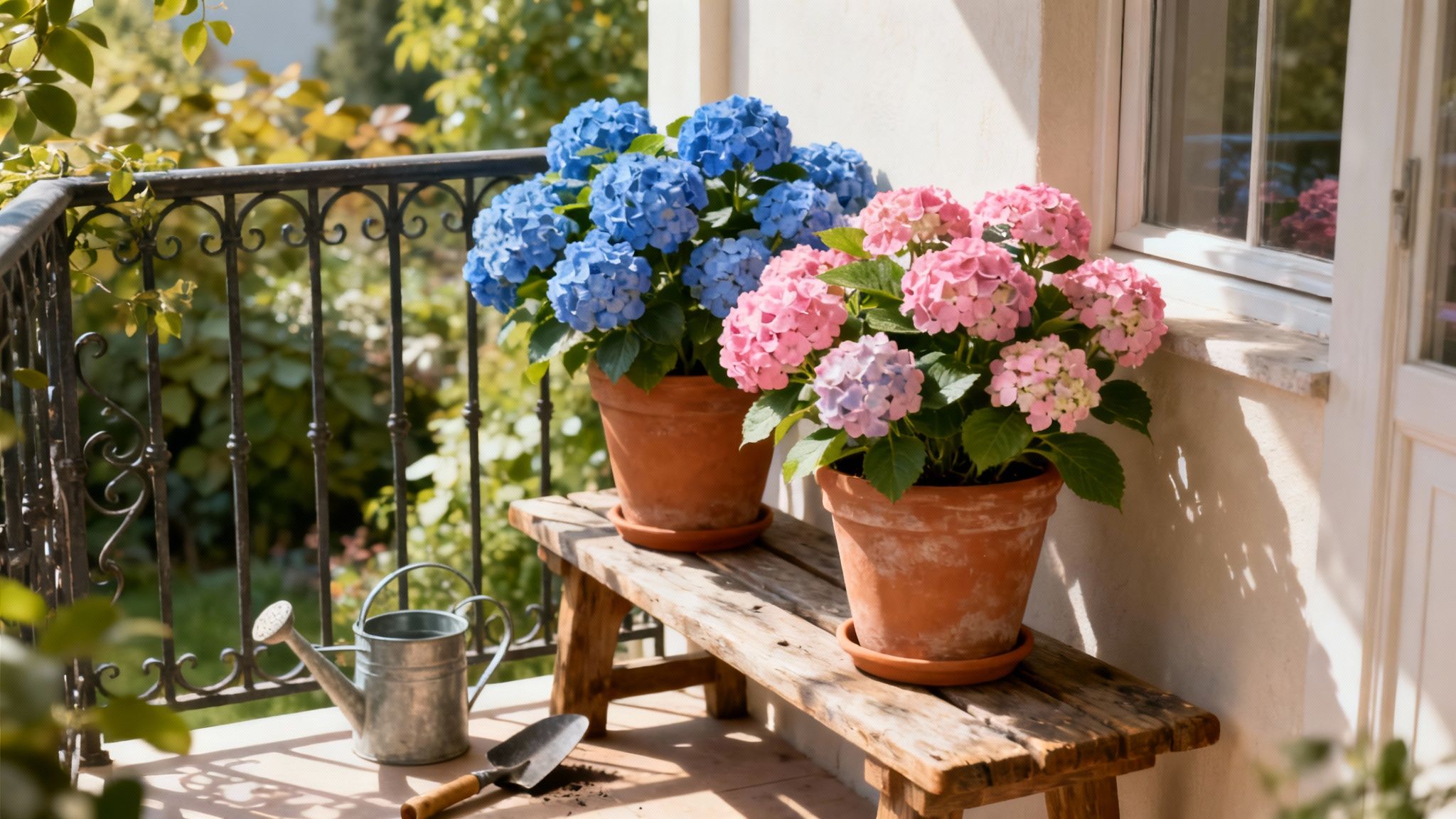Venturing into the world of houseplants can seem daunting, but the rewards of a greener living space, from cleaner air to a calmer mind, are well worth the effort. The secret isn't some mystical 'green thumb'; it's about starting with the right companions. This guide is specifically designed for anyone who thinks they can't keep a plant alive, offering a curated selection of exceptionally hardy and stylish indoor plants for beginners.
We have organised a definitive list of eight resilient plants, each chosen for its ability to thrive with minimal fuss and forgive the occasional oversight. Forget generic advice. For each plant, we provide precise, actionable care instructions, from watering schedules to optimal light conditions. You will learn not just which plants to choose, but exactly how to integrate them into your home for maximum visual impact and health benefits. By the end of this roundup, you will have the practical knowledge and confidence to transform your home into a verdant sanctuary. This list is your foundational step towards cultivating a beautiful and thriving indoor garden, one easy-care plant at a time.
1. Pothos (Epipremnum aureum)
Often affectionately nicknamed 'Devil's Ivy' for its sheer resilience, the Pothos is arguably the quintessential starting point for anyone venturing into the world of houseplants. This trailing vine, with its characteristic heart-shaped leaves, is exceptionally forgiving and adapts to a wide range of indoor environments. Its near-indestructible nature makes it one of the best indoor plants for beginners, as it can tolerate occasional neglect and less-than-ideal conditions while still looking lush and vibrant.
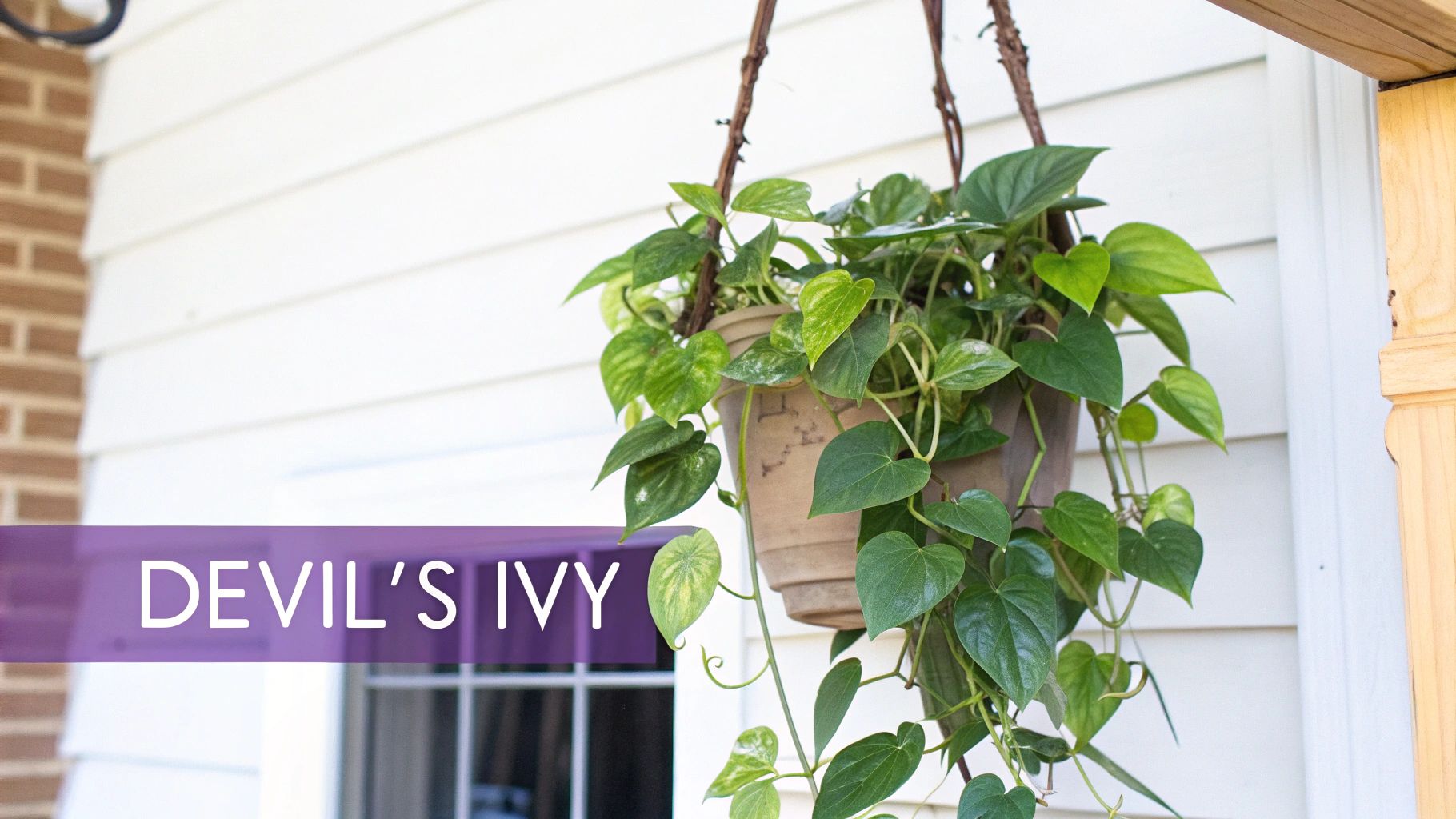
Its popularity isn't just anecdotal; Pothos is a common sight in commercial spaces like offices and cafes precisely because of its low-maintenance demands and aesthetic appeal. It thrives in hanging planters where its vines can cascade elegantly, or it can be trained to climb a small trellis. Notably, its air-purifying qualities were highlighted in NASA's Clean Air Study, making it a functional and beautiful addition to any room.
Key Care and Styling Tips
To ensure your Pothos thrives, focus on a few simple practices. Proper care will not only keep your plant healthy but also encourage the full, trailing growth that makes it so popular.
- Watering Schedule: Check the soil weekly. When the top inch feels dry to the touch, it's time to water thoroughly. Pothos is more tolerant of underwatering than overwatering, which can lead to root rot.
- Encourage Fullness: To prevent the vines from becoming long and sparse, periodically pinch back the growing tips. This simple action encourages the plant to branch out, creating a much bushier and more robust appearance.
- Light and Location: While it tolerates low light, Pothos does best in medium to bright, indirect sunlight. Keep it away from direct sun, which can scorch its leaves. Rotating the plant weekly helps ensure all sides receive equal light for balanced growth.
- Simple Propagation: One of the most rewarding aspects of owning a Pothos is how easily you can create new plants. Simply snip a cutting below a node (the small bump on the stem) and place it in a glass of water. Roots will form in a few weeks, ready to be planted in soil.
2. Snake Plant (Sansevieria trifasciata)
Also known as 'Mother-in-Law's Tongue', the Snake Plant is a striking succulent celebrated for its hardiness and architectural beauty. Its upright, sword-like leaves feature distinctive patterns, making it a bold statement piece that is exceptionally easy to care for. This plant's resilience makes it one of the top indoor plants for beginners, as it thrives on neglect and can withstand long periods without water, making it perfect for busy homeowners or frequent travellers.
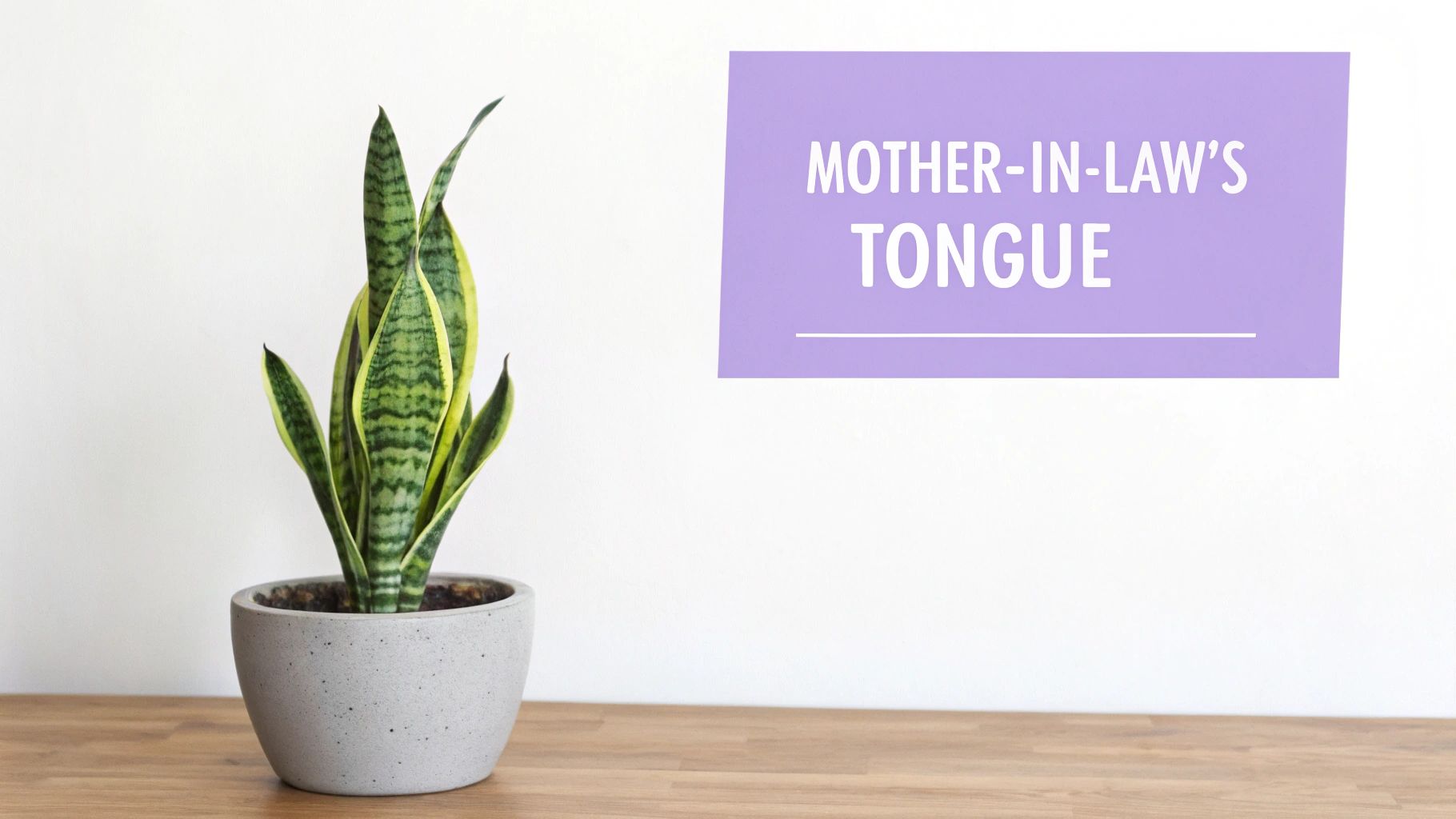
Its popularity in minimalist and modern interior designs stems from its clean, vertical lines. Like the Pothos, the Snake Plant was also featured in NASA's Clean Air Study for its ability to filter indoor air pollutants. Uniquely, it releases oxygen at night, making it an excellent choice for bedrooms. Its tolerance for low-light conditions also makes it a common fixture in office environments where natural light may be scarce, proving its adaptability and functional elegance.
Key Care and Styling Tips
To keep your Snake Plant looking sharp and healthy, a 'less is more' approach is key. Proper care ensures its structural leaves remain firm and its vibrant colouring is maintained.
- Watering Schedule: This is where beginners often go wrong. Snake Plants are succulents and prone to root rot. Allow the soil to dry out completely between waterings, which could mean watering as little as once a month or even less in winter.
- Prevent Dust Build-up: The large, flat surfaces of the leaves can accumulate dust, which can hinder photosynthesis. Gently wipe them down with a damp cloth every month to keep them clean and able to absorb light efficiently.
- Light and Location: Extremely versatile, it will tolerate low light but truly thrives in medium to bright, indirect sunlight, which will enhance the colouring of its leaves. Keep it out of harsh, direct sun to prevent scorching.
- Simple Propagation: The easiest way to create new Snake Plants is by division. During repotting, you can gently separate the root clusters (rhizomes) into smaller sections and plant them in their own pots with well-draining soil.
3. Spider Plant (Chlorophytum comosum)
A classic for a reason, the Spider Plant is a wonderfully cheerful and resilient addition to any home. With its distinctive fountain-like arching leaves and the delightful baby plantlets, or 'spiderettes', that dangle from long stems, it brings a sense of life and movement to a space. It has been a household favourite since the Victorian era and remains one of the best indoor plants for beginners due to its easy-going nature and minimal demands.
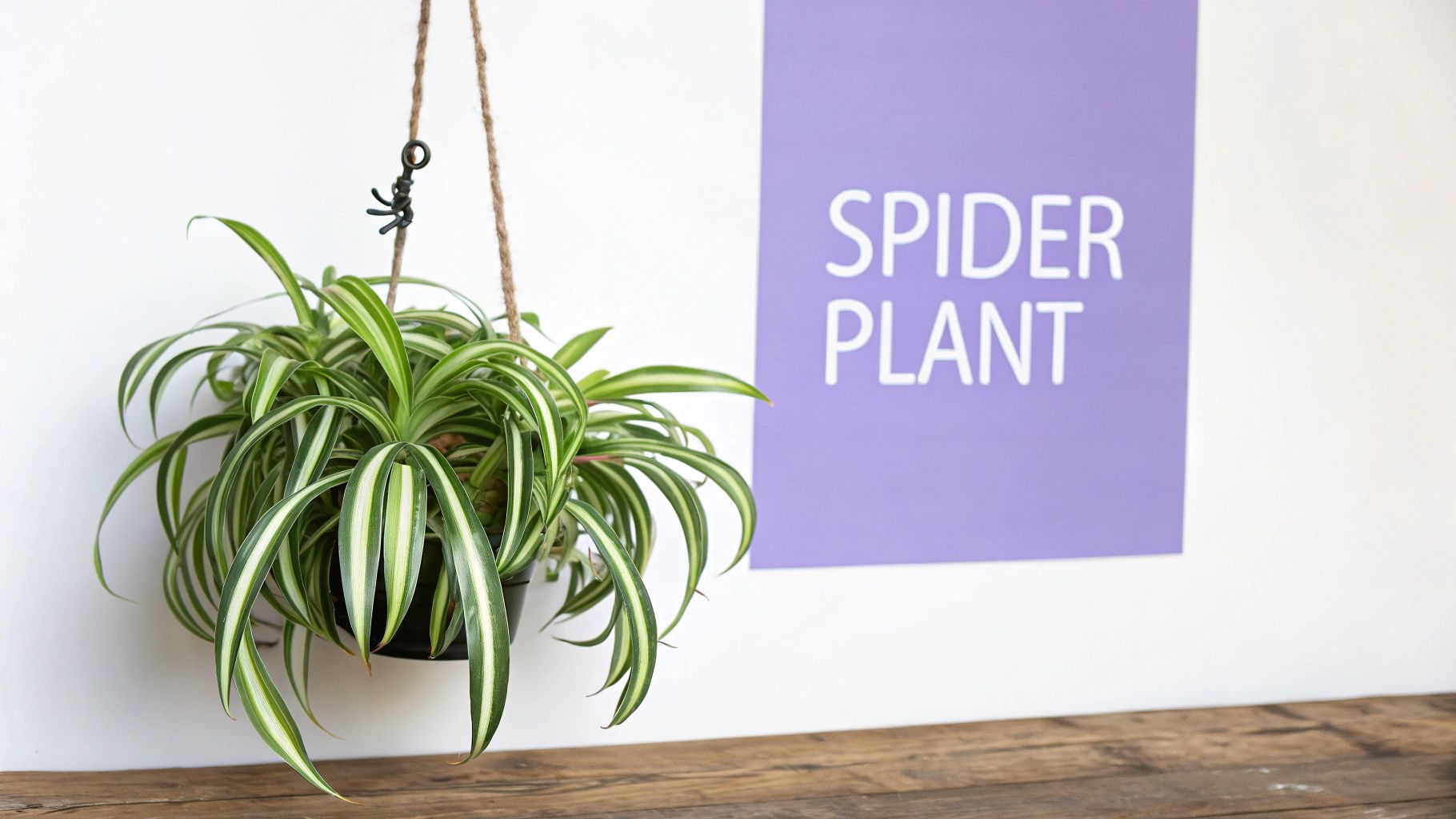
This plant’s adaptability makes it a perfect fit for various settings. It’s a traditional choice for hanging planters in sunrooms where its spiderettes can cascade freely, and its non-toxic properties make it a safe and popular option for children's rooms or homes with pets. Its forgiving nature also means it is frequently featured in beginner gardening courses and propagation workshops, teaching new plant parents the joys of creating more green life from a single, thriving parent.
Key Care and Styling Tips
Keeping your Spider Plant happy is straightforward. By following a few simple care guidelines, you can ensure it grows into a lush, feature plant that generously produces new offshoots.
- Watering Schedule: Water your Spider Plant thoroughly when the top inch of soil feels dry. They prefer consistently moist soil but not waterlogged conditions. Using distilled or rainwater can help prevent brown leaf tips, which are often caused by fluoride and other minerals in tap water.
- Encourage Fullness: The plant naturally creates a full appearance as it matures and produces spiderettes. There is little need for pruning unless you are removing brown tips. To encourage more offshoots, ensure the plant receives adequate light and is slightly pot-bound.
- Light and Location: Provide bright, indirect light for the best growth and variegation. While it can survive in lower light, its growth may become slower and less vibrant. Direct sunlight can scorch its leaves, so a spot near an east-facing window is ideal.
- Simple Propagation: Propagating a Spider Plant is incredibly easy and rewarding. Once the spiderettes have developed small roots of their own, simply snip them from the mother plant. Place them in a small pot of soil or a glass of water until their root system is more established before potting.
4. Rubber Plant (Ficus elastica)
For those wanting to make a bolder statement, the Rubber Plant is a fantastic choice that combines dramatic looks with a surprisingly easy-going nature. This stately plant, native to Southeast Asia, features large, glossy, deep-green leaves and an upright growth habit that adds a touch of architectural elegance to any space. It is one of the most rewarding indoor plants for beginners because it offers the visual impact of a small indoor tree without the complex care requirements.
Its ability to adapt to typical indoor environments makes it a popular floor plant in modern living rooms and a common sight in stylish office lobbies. As a statement piece, it commands attention and fills vertical space beautifully, making it a go-to for interior designers. Despite its impressive size, its needs are simple, allowing novice plant owners to cultivate a stunning specimen with minimal fuss.
Key Care and Styling Tips
To keep your Rubber Plant healthy and looking its best, a few simple care routines are all that's required. Proper attention will encourage strong, upright growth and maintain the beautiful sheen of its leaves.
- Watering Schedule: Water when the top inch of soil feels dry. Give it a good soak until water drains from the bottom, but do not let it sit in a saucer of water, as this can lead to root rot. It is more tolerant of being slightly dry than too wet.
- Maintain Leaf Shine: The large leaves can accumulate dust, which dulls their appearance and can block light. Gently wipe them with a damp, soft cloth every month to keep them clean, glossy, and healthy.
- Light and Location: Place your Rubber Plant in a spot with plenty of bright, indirect sunlight. While it can tolerate slightly lower light levels, it will thrive and grow more vigorously with good light. Direct sun can scorch the leaves, so avoid south-facing windows without a curtain.
- Encourage Bushy Growth: To control its height and encourage a fuller shape, you can prune your Rubber Plant in the spring. Trimming the top will prompt the plant to branch out from below the cut, creating a more robust form.
5. Peace Lily (Spathiphyllum)
An elegant and sophisticated choice, the Peace Lily is beloved for its glossy, dark green leaves and iconic white spathes that resemble flowers. Native to the tropical rainforests of the Americas, it brings a touch of serene beauty to any room. Its ability to communicate its needs clearly, particularly when it comes to watering, makes it an excellent option for those new to plant care. This makes it one of the most rewarding indoor plants for beginners who want a plant that offers both lush foliage and periodic blooms.
Often given as a gesture of sympathy, the Peace Lily is also a popular feature in office spaces and homes for its graceful appearance and air-purifying capabilities, as noted in NASA's Clean Air Study. It thrives in the higher humidity found in bathrooms or kitchens but adapts well to most indoor environments. Unlike many houseplants, it reliably flowers indoors, offering a rewarding visual cue that you are providing proper care.
Key Care and Styling Tips
To keep your Peace Lily looking its best and encourage its beautiful white blooms, focus on a few key care points. These simple practices will help you maintain a healthy and striking plant.
- Watering Schedule: The Peace Lily is famous for its dramatic droop when it's thirsty. This visual cue is a beginner's best friend. Water thoroughly when you notice the leaves just starting to wilt, and it will perk up within hours. Use filtered or distilled water if possible, as it can be sensitive to chemicals in tap water.
- Encourage Flowering: To promote blooms, place your plant in a spot with bright, indirect light. Low light will keep the foliage healthy, but more light is needed for the white spathes to develop. Snip off spent flowers at the base of their stalk to redirect the plant's energy into producing new growth and more blooms.
- Light and Location: Find a spot away from direct sunlight, which can burn its leaves. An east-facing window or a few feet back from a south or west-facing window is ideal. Peace Lilies also appreciate higher humidity, making them a great choice for a well-lit bathroom.
- Simple Maintenance: Keep the large leaves free of dust by wiping them down with a damp cloth every few months. This not only keeps the plant looking good but also helps it to photosynthesise more effectively.
6. ZZ Plant (Zamioculcas zamiifolia)
Known for its striking, architectural appearance, the ZZ Plant is a modern houseplant superstar. Its deep green, waxy leaves grow upwards on graceful, wand-like stems, creating a bold statement with minimal effort. Hailing from the drought-prone regions of Eastern Africa, its incredible resilience makes it one of the most forgiving indoor plants for beginners, particularly for those with a busy lifestyle or a forgetful watering hand.
The ZZ Plant’s rise to fame in recent decades is no surprise; it's a common feature in minimalist interior design schemes and modern office buildings precisely because it thrives on neglect. Its ability to tolerate very low light levels means it can brighten up a dim corner where other plants would struggle. This near-indestructible quality makes it an ideal choice for frequent travellers or anyone seeking a stylish, living sculpture that asks for very little in return.
Key Care and Styling Tips
To keep your ZZ Plant looking its best, a 'less is more' approach is key. Its needs are simple, but getting them right will ensure its structural beauty remains a highlight in your home.
- Watering Schedule: This is the most crucial element of ZZ care. Its underground rhizomes store water, making it extremely susceptible to root rot from overwatering. Allow the soil to dry out completely between waterings, checking every 2-4 weeks. When in doubt, it’s always better to wait.
- Light and Location: While the ZZ Plant is famous for its low-light tolerance, it performs best in medium to bright, indirect light. It can even flourish under fluorescent office lighting. Keep it out of direct sunlight, which can burn its leaves.
- Basic Maintenance: The glossy leaves can accumulate dust over time, which can hinder photosynthesis. Gently wipe them down with a damp cloth once a month to keep them shiny and healthy.
- Soil and Feeding: Use a well-draining potting mix, such as one designed for cacti and succulents, to prevent waterlogging. The ZZ Plant is a slow grower and doesn’t require much fertiliser; feeding it once or twice during the spring and summer growing season is plenty.
7. Monstera Deliciosa
Known iconically as the ‘Swiss Cheese Plant’, the Monstera deliciosa has become a beloved centrepiece in modern home décor. Hailing from the tropical forests of Central America, its large, glossy leaves develop dramatic natural splits and holes (fenestrations) as they mature, giving it a distinctive, architectural look. Despite its exotic appearance, it’s surprisingly straightforward to care for, making it one of the most rewarding indoor plants for beginners looking to make a bold statement.
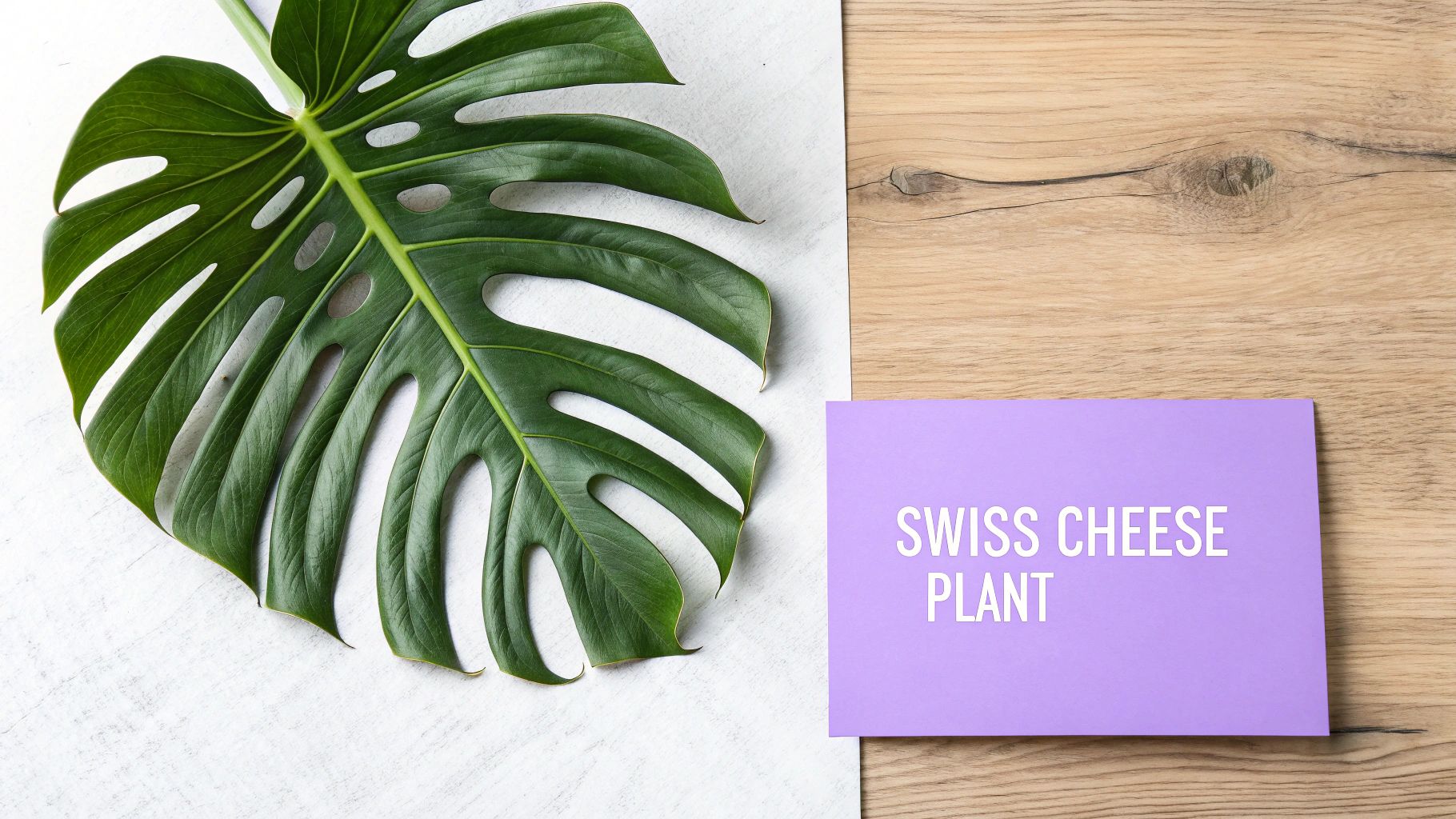
Its immense popularity on social media and in design magazines is well-deserved; this plant brings an instant touch of lush, jungle-like vibrancy to any space. It’s a popular choice for bright living rooms or sunrooms where it has space to grow. While young plants have solid, heart-shaped leaves, providing the right care encourages the development of its famous fenestrations, a truly satisfying milestone for any new plant parent.
Key Care and Styling Tips
To help your Monstera flourish and develop its signature splits, a few key practices are essential. Proper care will not only keep it healthy but also encourage it to grow into an impressive specimen plant.
- Watering Schedule: Water thoroughly when the top two inches of soil feel dry. Monsteras prefer soil that is consistently moist but not waterlogged, as this can lead to root rot. Allow excess water to drain away completely after watering.
- Encourage Climbing: In its natural habitat, the Monstera is a climber. Providing a moss pole or small trellis for support mimics this environment, encouraging larger leaf growth and a more stable, upright structure. Gently tie the main stems to the support as it grows.
- Light and Location: Bright, indirect light is the key to a happy Monstera and good fenestration. It can tolerate lower light levels, but its leaves will be smaller and less likely to split. Avoid direct sunlight, which can burn the leaves.
- Keep Leaves Clean: The large leaves can accumulate dust, which can block light and hinder photosynthesis. Gently wipe them down with a damp cloth every few weeks to keep them glossy, healthy, and able to breathe.
8. Aloe Vera (Aloe barbadensis miller)
Valued for thousands of years for its medicinal properties, Aloe Vera is a practical and attractive succulent that's incredibly easy to care for. This plant features thick, fleshy leaves that radiate from a central base, storing water and making it highly drought-tolerant. Its unique architectural form and dual purpose as both a decorative plant and a source of soothing gel make it one of the most rewarding indoor plants for beginners, especially for those who appreciate functional beauty.
Aloe Vera is a common sight on kitchen windowsills, where its gel is readily accessible for minor burns or skin irritation. Its low-maintenance nature means it thrives on a bit of neglect, making it ideal for busy homeowners or first-time plant parents. As a succulent, it brings a touch of desert elegance to any room and works well in mixed succulent arrangements or as a standalone statement piece.
Key Care and Styling Tips
To keep your Aloe Vera healthy and encourage its growth, a few specific practices are key. Proper care ensures it remains a robust and useful addition to your home.
- Watering Schedule: Water deeply but infrequently. Allow the soil to dry out completely between waterings to prevent root rot, its most common issue. In winter, reduce watering even further.
- Encourage Fullness: Aloe Vera naturally produces new plants, called 'pups' or 'offsets', around the base of the mother plant. Once these pups are a few inches tall, you can gently separate them and pot them individually to create new plants and maintain a tidy appearance.
- Light and Location: Provide plenty of bright, indirect sunlight. A south-facing window is ideal, but be careful to avoid direct, scorching sun which can turn the leaves brown. It’s a perfect plant for a sunny windowsill.
- Simple Propagation: Beyond separating pups, you can harvest the gel from mature, outer leaves. Simply slice off a leaf close to the base. The plant will heal itself, and you can use the fresh gel for skincare. Always start with the outermost leaves, as they are the oldest and most potent.
Beginner-Friendly Indoor Plants Comparison
Your Journey to a Greener Home Has Begun
Embarking on the adventure of plant parenthood is a truly rewarding experience, transforming not just the look of your home but your connection to the natural world. Throughout this guide, we've explored a curated selection of eight resilient and beautiful indoor plants for beginners. From the famously indestructible Snake Plant and the forgiving ZZ Plant, perfect for those with a less-than-consistent watering schedule, to the fast-growing Pothos that offers instant gratification, each plant provides a low-risk entry point into the world of home horticulture.
You've learned that even a statement plant like the Monstera Deliciosa is surprisingly manageable, and that functional plants like Aloe Vera can be both stylish and useful. The key takeaway is that you don't need a magical "green thumb" to succeed. Success is built on observation, a little patience, and choosing the right plant for your specific environment.
Your Actionable Next Steps to Plant Success
Feeling inspired? The best way to build confidence is to start small and grow from there. Here’s a simple plan to get you started on your green journey:
- Assess Your Space: Before you even head to the garden centre, take a moment to observe your home. Where do you get bright, indirect light? Which corners are a bit shadier? Matching the plants from our list, such as a Peace Lily for lower light or a Rubber Plant for a bright spot, to your available conditions is the single most important step.
- Start with One or Two: It’s tempting to buy an entire jungle at once, but it’s wiser to begin with just one or two plants from our list. This allows you to learn their specific needs and watering rhythms without feeling overwhelmed. A Spider Plant or a Pothos are excellent first choices as they visually communicate their needs very clearly.
- Master the Basics: Focus on the core principles we've discussed: avoid overwatering, ensure proper drainage, and understand the light requirements. Remember, it's far easier to rescue an under-watered plant than an over-watered one. Don't be afraid to stick your finger an inch or two into the soil to check for dampness.
Key Insight: Your plants are living organisms that will communicate with you. A yellowing leaf, a droopy stem, or slow growth are not signs of failure; they are simply feedback. Learning to interpret this feedback is the most valuable skill a new plant owner can develop.
Ultimately, cultivating an indoor garden is about more than just decoration. It’s a mindful hobby that reduces stress, purifies the air, and adds a dynamic, living element to your space. Each new leaf is a small victory, and even the occasional setback is a learning opportunity. You now have the foundational knowledge to select and care for some of the hardiest indoor plants for beginners. So go ahead, choose your first green companion, and watch with pride as your home, and your confidence, begins to flourish.

